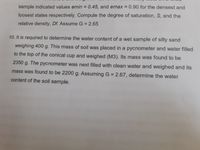
Structural Analysis
6th Edition
ISBN: 9781337630931
Author: KASSIMALI, Aslam.
Publisher: Cengage,
expand_more
expand_more
format_list_bulleted
Concept explainers
Question
thumb_up100%

Transcribed Image Text:sample indicated values emin = 0.45, and emax = 0.90 for the densest and
%3D
loosest states respectively. Compute the degree of saturation, S, and the
relative density, Df. Assume G = 2.65
%3D
10. It is required to determine the water content of a wet sample of silty sand
weighing 400 g. This mass of soil was placed in a pycnometer and water filled
to the top of the conical cup and weighed (M3). Its mass was found to be
2350 g. The pycnometer was next filled with clean water and weighed and its
mass was found to be 2200 g. Assuming G = 2.67, determine the water
%3D
content of the soil sample.
Expert Solution
This question has been solved!
Explore an expertly crafted, step-by-step solution for a thorough understanding of key concepts.
Step by stepSolved in 2 steps with 1 images

Knowledge Booster
Learn more about
Need a deep-dive on the concept behind this application? Look no further. Learn more about this topic, civil-engineering and related others by exploring similar questions and additional content below.Similar questions
- Consider that a 58.7 gram sample of dry soil is used in making a mechanical analysis by using the hydrometer method. The laboratory was held at a constant temperature of 20 C (68 F). The 40 s hydrometer reading was found to be 32.5 and the 8 hr hydrometer reading was 15.5. The percentage of sand in this soil sample is (note, a 58.7 gram sample is used here): Your Answer: Answer unitsarrow_forwardA carefully-weighed 52.9 gram soil sample was dispersed for particle-size analysis using the Bouyoucos hydrometer method. The laboratory was held at a constant temperature of 20 C (68 F). The hydrometer reading after 40 seconds was 20.1 and the hydrometer reading after 8 hours was 5.1. What percentage of particles in the soil sample were clay-sized? Your Answer: Answer unitsarrow_forwardhelp me find thisarrow_forward
- 1.4 A test for the relative density of soil in place was performed by digging a small hole in the soil. The volume of the hole was 400 ml and the moist weight of the excavated soil was 9 N. after oven drying, the weight was 7.8 N. Of the dried soil, 4N was poured into a vessel in a very loose state, and its volume was found to be 270 ml. The same weight of soil when vibrated and compacted had a volume of 200 ml. Determine the relative density.arrow_forwardCalculate K for the soil tested in the figure. Assume the cross-sectional area of the sample is 14 cm² and the area of the standpipe is 2cm². The time of test = 15 min. All dimensions shown are in mm. D 270 T 200 soil 70 580 310arrow_forward
arrow_back_ios
arrow_forward_ios
Recommended textbooks for you

 Structural Analysis (10th Edition)Civil EngineeringISBN:9780134610672Author:Russell C. HibbelerPublisher:PEARSON
Structural Analysis (10th Edition)Civil EngineeringISBN:9780134610672Author:Russell C. HibbelerPublisher:PEARSON Principles of Foundation Engineering (MindTap Cou...Civil EngineeringISBN:9781337705028Author:Braja M. Das, Nagaratnam SivakuganPublisher:Cengage Learning
Principles of Foundation Engineering (MindTap Cou...Civil EngineeringISBN:9781337705028Author:Braja M. Das, Nagaratnam SivakuganPublisher:Cengage Learning Fundamentals of Structural AnalysisCivil EngineeringISBN:9780073398006Author:Kenneth M. Leet Emeritus, Chia-Ming Uang, Joel LanningPublisher:McGraw-Hill Education
Fundamentals of Structural AnalysisCivil EngineeringISBN:9780073398006Author:Kenneth M. Leet Emeritus, Chia-Ming Uang, Joel LanningPublisher:McGraw-Hill Education
 Traffic and Highway EngineeringCivil EngineeringISBN:9781305156241Author:Garber, Nicholas J.Publisher:Cengage Learning
Traffic and Highway EngineeringCivil EngineeringISBN:9781305156241Author:Garber, Nicholas J.Publisher:Cengage Learning


Structural Analysis (10th Edition)
Civil Engineering
ISBN:9780134610672
Author:Russell C. Hibbeler
Publisher:PEARSON

Principles of Foundation Engineering (MindTap Cou...
Civil Engineering
ISBN:9781337705028
Author:Braja M. Das, Nagaratnam Sivakugan
Publisher:Cengage Learning

Fundamentals of Structural Analysis
Civil Engineering
ISBN:9780073398006
Author:Kenneth M. Leet Emeritus, Chia-Ming Uang, Joel Lanning
Publisher:McGraw-Hill Education


Traffic and Highway Engineering
Civil Engineering
ISBN:9781305156241
Author:Garber, Nicholas J.
Publisher:Cengage Learning